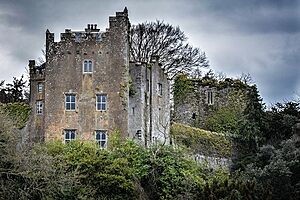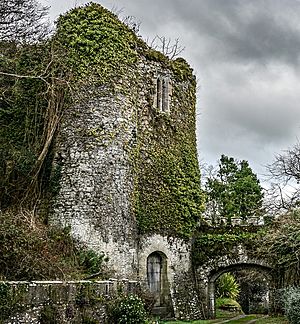Ardfinnan Castle facts for kids
Ardfinnan Castle is a very old castle in County Tipperary, Ireland. It was built around 1185. This castle was made to protect a river crossing at a place called Ardfinnan. It's like a sister castle to Lismore Castle.
Ardfinnan Castle sits on a big rocky hill. From there, it looks over the Suir valley. You can see the Knockmealdown Mountains and the Galtee Mountains from the castle. The castle is shaped like a rectangle. It has square towers at its corners and a strong entrance gate.
Early History of Ardfinnan Castle
The castle was built in 1185 by order of John, Lord of Ireland. He wanted to protect the northern border of Waterford. John's father, Henry II of England, thought Ardfinnan was a key spot for a castle. It was important because it guarded a way from the coast into central Ireland.
John arrived in Waterford in April 1185. He gave the land of Ardfinnan to a knight named Maurice de Prendergast. Maurice was told to build Ardfinnan Castle and protect it. He became its governor.
But the Irish Kings were not happy about these new castles. Lismore Castle was attacked and taken. Its governor and soldiers were killed. Then, King Donal O'Brien, King Rory O'Conner, and King Dermod MacCarthy headed for Ardfinnan.
Donal O'Brien saw that the castle was too strong to take by force. He pretended to retreat. The small group of knights from Ardfinnan Castle chased after him. This was a trick! O'Brien quickly turned back and surrounded the knights. Many of them were killed, and Ardfinnan Castle was taken.
After this and other losses, John's army was much smaller. By December 1185, his father called him back to England.
The castle was soon taken back by the Anglo-Normans. It kept changing owners many times. Later, it was given to the Knights Templar. After them, it went to the Knights Hospitaller. These Hospitaller knights built the castle's round tower, called a keep, in the early 1200s. This tower helped them protect the important pass between Cashel and Lismore.
Cromwell's Attack
In 1650, a general named Henry Ireton came to Ardfinnan. He was with Oliver Cromwell, who was conquering Ireland. Ireton needed to cross the River Suir with his army. He went to the bridge at Ardfinnan.
The castle guarded this crossing from high up. Ireton decided to attack it. He waited until early morning. Inside the castle, David Fitzgibbon was defending it for King Charles II. He had only a small group of soldiers.
Ireton placed cannons on a hill across from the castle. He fired at its strong walls. After about eight shots, a big hole was made in the wall. Ireton's soldiers then went in. They killed about thirteen of the castle's guards. Ireton's side lost only two men.
After this, the castle was quickly given up to Cromwell's army. They used it as a base. David Fitzgibbon was allowed to live because he surrendered quickly. But he lost his lands at Ardfinnan.
When Cromwell's campaign in Ireland ended, his soldiers damaged Ardfinnan Castle. This left parts of it in ruins.
British Army Camp
In 1795, there was a fear of invasion during the French Revolutionary Wars. So, Ardfinnan Castle was used again by the military. British soldiers were stationed there.
Even though it was partly ruined, the castle's location was still very important. It guarded a main crossing on the River Suir. The area around Ardfinnan was used as a summer training camp for the British Army. Soldiers practiced firing and marching. They were getting ready in case the French invaded.
At first, this camp was only for the summer. But in March 1796, it became a permanent camp. About 2,740 soldiers were there. The camp was closed down by 1802.
Castle Restoration
In the early 1800s, Ardfinnan Castle and its land were given back to the family of Maurice de Prendergast.
Around 1846, the castle's main tower was fixed up. This was during the Victorian times. More buildings were added next to it. The castle was changed into a large country house.
The last man from this family to live in the castle was Admiral Sir Robert Prendergast. He moved away after he retired in 1920.
From 1922, the Mulcahy family owned the castle. They owned the successful Ardfinnan Woollen Mills nearby. The castle overlooks these mills. More repairs were made to the house by 1929. The newest part, a three-story wing, was probably added in the 1930s.



